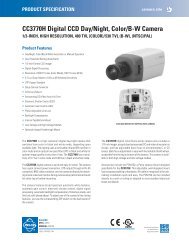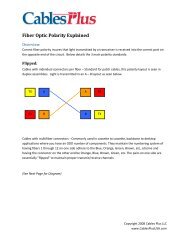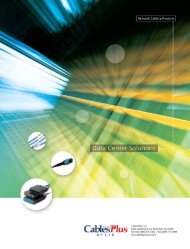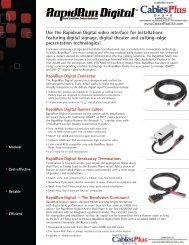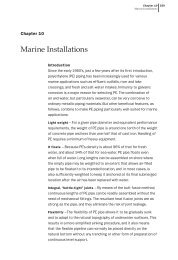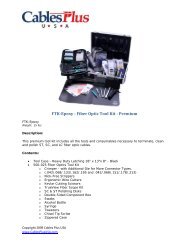Learning About Options in Fiber - Cables Plus USA
Learning About Options in Fiber - Cables Plus USA
Learning About Options in Fiber - Cables Plus USA
Create successful ePaper yourself
Turn your PDF publications into a flip-book with our unique Google optimized e-Paper software.
HISTORY<br />
SECTION 1—INTRODUCTION TO FIBER<br />
INFORMATION TRANSMISSION<br />
The use of light for the transmission of <strong>in</strong>formation<br />
is far from a new idea. Paul Revere’s lanterns were<br />
used to signal the approach of the British. And it<br />
was Alexander Graham Bell’s experiments over a<br />
century ago that led to his development of the<br />
photophone, a device that carried speech from<br />
one po<strong>in</strong>t to another by means of vibrat<strong>in</strong>g mirrors<br />
and a beam of sunlight.<br />
Although never a commercial success, it nevertheless<br />
demonstrated the feasibility of lightwave communications.<br />
However the technique was shunted<br />
aside and virtually forgotten for almost another<br />
hundred years.<br />
It probably would have rema<strong>in</strong>ed <strong>in</strong> limbo had it not<br />
been for the appearance of a device called the<br />
laser.<br />
Laser is an acronym for Light Amplification by<br />
Stimulated Emission of Radiation.<br />
Simply described, the laser is a device that produces<br />
a unique k<strong>in</strong>d of radiation — an <strong>in</strong>tensely<br />
bright light which can be focused <strong>in</strong>to a narrow<br />
beam of precise wavelength. The tremendous<br />
energies of the laser stem from the fact that it produces<br />
what is called coherent light .<br />
<strong>Fiber</strong> optics is a relatively new technology that<br />
uses rays of light to send <strong>in</strong>formation over hair-th<strong>in</strong><br />
fibers at bl<strong>in</strong>d<strong>in</strong>g speeds. These fibers are used<br />
as an alternative to conventional copper wire <strong>in</strong> a<br />
variety of applications such as those associated<br />
with security, telecommunications, <strong>in</strong>strumentation<br />
and control, broadcast or audio/visual systems.<br />
Today the ability to transmit huge amounts of <strong>in</strong>formation<br />
along slender strands of high-purity glass<br />
optical fiber with the speed of light has revolutionized<br />
communications.<br />
The large signal-carry<strong>in</strong>g capacity of optical fibers<br />
makes it possible to provide not only many more,<br />
but much more sophisticated signals than could<br />
ever be handled by a comparable amount of<br />
copper wire.<br />
ADVANTAGES/DISADVANTAGES<br />
The advantages of fiber over copper <strong>in</strong>clude:<br />
• Small Size: A 3/8-<strong>in</strong>ch (12 pair) fiber/cable<br />
operat<strong>in</strong>g at 140 mb/s can handle as many<br />
voice channels as a 3-<strong>in</strong>ch diameter copper<br />
(900) twisted-pair cable.<br />
The light that comes from a candle or an <strong>in</strong>candescent<br />
bulb is called <strong>in</strong>coherent light. It's made<br />
up of many different, relatively short wavelengths<br />
(colors) which together appear white. They are<br />
sent out <strong>in</strong> brief bursts of energy at different times<br />
and <strong>in</strong> different directions. These <strong>in</strong>coherent light<br />
waves <strong>in</strong>terfere with each other, thus their energy<br />
is weakened, distorted, and diffused.<br />
The laser, on the other hand, emits light waves<br />
that all have the same wavelength, are <strong>in</strong> phase,<br />
and can be sharply focused to travel <strong>in</strong> the same<br />
direction over long distances with almost no dispersion<br />
or loss of power.<br />
Lasers provide radiation at optical and <strong>in</strong>frared<br />
frequencies. With lasers (and associated electronics)<br />
it became possible to perform at optical<br />
frequencies the electronics functions that eng<strong>in</strong>eers<br />
were accustomed to perform<strong>in</strong>g at conventional<br />
radio and microwave frequencies. Thus<br />
lasers promised the ability to channel signals with<br />
very high <strong>in</strong>formation rates along an extremely<br />
narrow path.<br />
1-1<br />
• Light Weight: The same fiber-optic cable<br />
weighs approximately 132 lbs per kilometer.<br />
The twisted pair cable weighs approximately<br />
16,000 lbs.<br />
• High Bandwidth: <strong>Fiber</strong> optics has been bandwidth<br />
tested at over 4-billion bits per second<br />
over a 100 km (60 miles) distance. Theoretical<br />
rates of 50-billion bits are obta<strong>in</strong>able.<br />
• Low Loss: Current s<strong>in</strong>gle-mode fibers have<br />
losses as low as .2 dB per km. Multimode<br />
losses are down to 1 dB (at 850 or 1300 nm).<br />
This creates opportunities for longer distances<br />
without costly repeaters.<br />
• Noise Immunity: Unlike wire systems, which<br />
require shield<strong>in</strong>g to prevent electromagnetic<br />
radiation or pick-up, fiber-optic cable is a<br />
dielectric and is not affected by electromagnetic<br />
or radio frequency <strong>in</strong>terference. The<br />
potential for lower bit error rates can <strong>in</strong>crease<br />
circuit efficiency.



